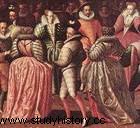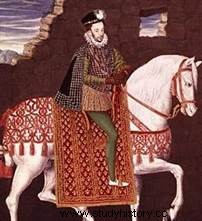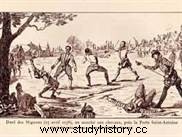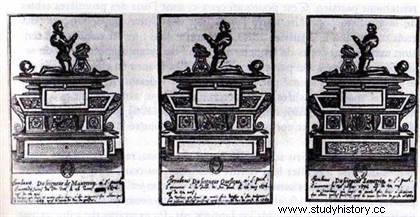 In general memory, favorites , cute , really cute are names evocative of scandal and used in a mocking and degrading way, especially during the reign of Henry III! And yet, kings, queens, high-ranking people very often surrounded themselves with a favourite, the trusted person, the intimate friend, showered with favors, whose political influence was more or less important. Let's put things in their place a little...because there were already favorites during Antiquity and then in the Middle Ages, but the most extensive period goes from the 15th century to the 17th century.
In general memory, favorites , cute , really cute are names evocative of scandal and used in a mocking and degrading way, especially during the reign of Henry III! And yet, kings, queens, high-ranking people very often surrounded themselves with a favourite, the trusted person, the intimate friend, showered with favors, whose political influence was more or less important. Let's put things in their place a little...because there were already favorites during Antiquity and then in the Middle Ages, but the most extensive period goes from the 15th century to the 17th century.
Under Francis I
The favorite under Francis I was an intimate, a public figure on whom the king could rely so that he wisely administered certain affairs of the kingdom. Elected among the courtiers, François I favored him on the basis of his merits, as was the case for Anne de Montmorency, the first favorite in France. Born in 1493, he proved his military values and became captain of a hundred lances at twenty-three, first gentleman of the chamber at twenty-seven, marshal of France at twenty-nine, grand master of France and governor of Languedoc in 1526, then finally constable of France twelve years later. Housed alongside the king, he had the honor of sleeping in the royal bedroom and chaired council meetings:a favorite considered a true head of government.
At the time of Henry II
When François I died, Henry II kept Anne de Montmorency and considered him his father. He was his adviser, his confidant, his friend and the intermediary character between the king and the courtiers. But on his death, mentalities changed, the two great families (Guise and Montmorency) fought to gain power during the handover to François II, because it was customary that on the death of the king, the successor got rid of old favorites to install his people around him.
The Duke of Anjou's changes
The Duke of Anjou is an open, generous, accessible prince, with a courteous and easy character, who you can talk to. He has around him childhood friends who are the sons of great figures in the court of the Queen Mother. From the siege of La Rochelle, the Duke of Anjou became a real party leader and formed a tight-knit bloc around him. The departure for Poland is an opportunity for these young people to embark on life, it is the first official dignity that presents itself to them. On the other hand, the king knew he could rely on the elders and it was thanks to them and their know-how that he returned to France in 1574.
The transformations of Henry III
 On her accession to the throne, the queen mother installed a first group of favorites around the king, composed of Villequier, Bellegarde and Le Guast who served as intermediaries between the king and the nobility, holding the monopoly of access to the king and representing authority. The young Lignerolles from a recent family, with no financial means, completes this group. Henri reformed life at court and surrounded himself with his friends, all young people between the ages of eighteen and twenty-four. He wants to create a place of intimacy, a space of friendship, trust, freedom, by deciding that his rising takes place in private, that courtiers are prohibited from entering, by wanting to promote noble ways around him. , with more refinement, prohibiting the unkempt under penalty of prohibition to approach it. Desiring to be master of the court and the center of the organization, he favors the minor nobility of the second order, thus disturbing the large houses or the heirs of powerful lineage who no longer have access to positions and favors. This is how he founds a new group around him.
On her accession to the throne, the queen mother installed a first group of favorites around the king, composed of Villequier, Bellegarde and Le Guast who served as intermediaries between the king and the nobility, holding the monopoly of access to the king and representing authority. The young Lignerolles from a recent family, with no financial means, completes this group. Henri reformed life at court and surrounded himself with his friends, all young people between the ages of eighteen and twenty-four. He wants to create a place of intimacy, a space of friendship, trust, freedom, by deciding that his rising takes place in private, that courtiers are prohibited from entering, by wanting to promote noble ways around him. , with more refinement, prohibiting the unkempt under penalty of prohibition to approach it. Desiring to be master of the court and the center of the organization, he favors the minor nobility of the second order, thus disturbing the large houses or the heirs of powerful lineage who no longer have access to positions and favors. This is how he founds a new group around him.
From the second group of favorites…
This second group, founded on friendship during the campaigns against the Huguenots and especially the trip to Poland, was made up from 1574 of Entraguet, Caylus, Saint Mégrin, Maugiron, Livarot , Saint Sulpice, Souvre, Gramont, Saint Luc and O. These young people of minor nobility, had arrived in Paris to study there, to learn the handling of the sword as well as the rudiments of horse riding, had already rubbed shoulders with the king and were thus admitted into his entourage. Gramont, Ribérac and the Schomberg brothers joined the group a little later.
To keep them with him, the king will transfer the charges of elders to them, but in return Bellegarde becomes marshal of France and is the only one authorized to enter the king's house without restriction, Le Guast obtains the post of camp master of the guards becoming an important element of a military network.
… to the Mignons du Roi
These young friends and courtiers take part in the feasts and copy the king in every way, especially in terms of clothing, their ways of behaving, having fun and being immediately belittled by the Protestants who accuse them of giving bad habits to young people, of living in artifice during cavalcades in the streets... remember that François Ier had done the same thing in 1517 with his friends.
From that moment on, they were nicknamed "the king's minions". This term appeared in the French language at the end of the Middle Ages; at the beginning of the 16th century, it qualifies a courtier with official dignity at court, brought up in the entourage of a Grand who expects loyalty and devotion in return; then in the middle of the century, the term means for the people:social disorder, associated with finesse, tenderness, beauty, with familiarity and sexual outbursts, from which the term “cute sleepers” appeared.
The people are amused at first, but do not understand that the king calls himself "His Majesty" and reacts badly. From 1576, the term took on a sexual and degrading connotation. A case of morals and murder, under cover of the king, does not favor their integration and the king himself is badly regarded.
The famous chronicler Pierre de l'Estoile described them thus in his diary of the reign of Henry III "This name of cute, began at that time to trot through the mouth of the people, to whom they were very odious, as much for their ways of doing things, which were playful and haughty, as for their effeminate and shameless make-up and attire, but above all for the immense gifts and liberalities that the king made to them, that the people had thought to be the cause of his downfall. These beautiful darlings wore their hair long, curly and curled by artifice, going up over their little velvet caps, like the whores of Bordeaux, and their strawberries of starched linen shirts half a foot long. , so that to see their head above their strawberry, it seemed that it was the head of Saint Jean in a dish. The rest of their clothing does the same; their exercises were to play, blaspheme, jump, dance, flit about, quarrel and babble, and follow the king everywhere and in all companies, doing nothing, saying nothing except to please him; caring little indeed for God and virtue, contenting themselves with being in good grace with their master whom they feared and honored more than God”.
“My Troop”
 After two years of reign, the minions are about twenty to gravitate around the king. These young people, whom the king readily calls "my troupe", are the sons of gentlemen playing a leading role in the provinces, employed in such a way as to reinforce royal authority in France. The minions form a group where fraternity, friendship and equality must reign, serving to adorn "his majesty". The king demands fidelity to his person, exclusivity and an assiduous presence.
After two years of reign, the minions are about twenty to gravitate around the king. These young people, whom the king readily calls "my troupe", are the sons of gentlemen playing a leading role in the provinces, employed in such a way as to reinforce royal authority in France. The minions form a group where fraternity, friendship and equality must reign, serving to adorn "his majesty". The king demands fidelity to his person, exclusivity and an assiduous presence.
Their mission
Cutes start by getting loads of ordinary gentlemen of the chamber, then move up the ranks and for some receive military commands like captains, camp masters, company commander of ordinance or infantry or light horse regiment for others, in order to retain the nobility of the provinces. However, in these regions, they cannot impose themselves, badly accepted, even rejected by the elders in place who do not want to give up their position.
But their main mission is to face other parties competing with the state, in particular by diverting the nobility to Monsieur (the king's brother) or to the Guise.
Depending on the degree of trust, certain favorites are admitted to the Council of State (management of the daily politics of the monarchy) or to the Business Council called the Secret Council where decisions are taken real political decisions. They then receive special missions such as important negotiations, the role of ambassador to the Guises, the intermediary between the king and the queen mother, the drafting of mail and dispatches. The first to participate were Saint Luc, Joyeuse, Villequier also participating in the Council of Finances, with d'O responsible for royal finances, Epernon took the title of Councilor of State and Business in 1582.
The favors granted
Of course, they receive income from their basic charges, but the favor system is not based on social status, nor on official charges, but on the emotional bond and on loyalty. Gifts and gratuities for services rendered prove favor with the king. Thus, young people obtain land and parents large offices in the provinces, in order to consolidate power and control opponents of the regime in the regions of France.
To increase the alliances in the provinces, and especially according to the merit of the minions (which proves their rapid rise), the king offers them considerable marriages as was the case for Caylus, Saint Sulpice and Saint Mégrin. This is a distinction compared to other gentlemen and Monsieur often tries to defeat these marriages thinking of losing his provincial nobility, this leading to duels between cuties.
And yet most of the minions are crippled with debt. Saint Luc and François d'O are the only ones of this generation to manage financially thanks to their positions as governors and income from abbeys...in return, they also had to make large loans to the state, from O and the future provost Richelieu ruined themselves there without ever being reimbursed. The mignons having to "appear" have enormously lavish expenses, creating houses with lackeys and stewards, leading a way of life above the norm, but they do not have sufficient income since they do not have significant expenses to pay. their name in the province. The king sometimes offers them bonuses, which they will not be able to take advantage of...they die too young!
The rivalries between cuties from both parties until the famous duel
 As we saw above, there is a recurring rivalry between Henry III and his brother and on the other hand Suddenly, a constant rivalry between the mignons of the two parties and incessant fights, leading to the disappearance of the mignons from 1575 until the famous collective duel of 1578. Cohabitation at court is difficult to live with in winter, on returning from war, violence is expressed by desires to fight. The minions also compete to retain the king's favor and it becomes a daily struggle. The duel is a kind of personal devotion, but in the present case, this collective death is more serious, the minions are animated by a community of spirit, they sacrifice themselves and die as martyrs, but the honor is washed away!
As we saw above, there is a recurring rivalry between Henry III and his brother and on the other hand Suddenly, a constant rivalry between the mignons of the two parties and incessant fights, leading to the disappearance of the mignons from 1575 until the famous collective duel of 1578. Cohabitation at court is difficult to live with in winter, on returning from war, violence is expressed by desires to fight. The minions also compete to retain the king's favor and it becomes a daily struggle. The duel is a kind of personal devotion, but in the present case, this collective death is more serious, the minions are animated by a community of spirit, they sacrifice themselves and die as martyrs, but the honor is washed away!
The month of January 1578 was spent in harassment between Bussy, Monsieur's "champion", and Gramont, one of the king's minions. The mignons then form a group made up of Gramont, Saint Luc, Caylus, Saint Mégrin, Mauléon, Livarot, Maugiron, to which are added at the beginning of February O, the brothers Schomberg and Joyeuse. After a few attacks, Bussy demands justice, Caylus is officially condemned, but everything degenerates after the wedding of Saint Luc where Monsieur does not appear since he leaves the court. Following a new quarrel between Caylus and Entraguet, a group of six minions belonging to the king and to Monsieur, clash on April 26, 1578, a day called "the day of the pigs" on the Horse Market near the Saint Antoine gate.
Caylus, Maugiron and Saint Mégrin are buried with great honours. Ronsard sings their praises, sonnets are engraved on the tombs, the praises are expressed in terms of beauty, bravery, courtesy, honor, virtue. The king intends to assimilate the deceased to the dignitaries of the kingdom, even to the royal children and has marble mausoleums installed in the church of Saint Paul, which will be destroyed by the people in January 1589, at the instigation of preachers; these honors rendered accentuate the deterioration of the king's popularity.
The king is down, has changed a lot and will restrict the number of people around him. He wishes to have only two interlocutors to whom he entrusts political missions.
It is the end of the youth group and the last favorites Souvré, Châteauvieux, Guiche and Beauvais-Nangis who were at the siege of La Rochelle, who followed the king to Poland , who have earned only gentleman of the chamber appointments, constitute the "contrary cabal" to thwart the power of a new rising group referred to as the "archi-cutes".
The super cute
 From 1581, date of the disgrace of the elders, it was a period of peace in the kingdom and the king, who since 1577 has attached a small group of three people Anne de Joyeuse d'Arques and his brothers from Bouchage, Jean Louis de Nogaret de La Valette and his brothers, as well as François d'O, feels well, is serene, balanced, in good health, is again accessible to the nobility. Companions in the King's private life, they followed him everywhere, served him at table, accompanied him to receptions and public ceremonies and helped to maintain a balance between Henry III's private and public life. Despite everything, they act as a bulwark against beggars and everyone has to go through them to even get an interview with the king.
From 1581, date of the disgrace of the elders, it was a period of peace in the kingdom and the king, who since 1577 has attached a small group of three people Anne de Joyeuse d'Arques and his brothers from Bouchage, Jean Louis de Nogaret de La Valette and his brothers, as well as François d'O, feels well, is serene, balanced, in good health, is again accessible to the nobility. Companions in the King's private life, they followed him everywhere, served him at table, accompanied him to receptions and public ceremonies and helped to maintain a balance between Henry III's private and public life. Despite everything, they act as a bulwark against beggars and everyone has to go through them to even get an interview with the king.
Their missions
Serving as intermediaries between the king and the nobility, they combine the charges of the court, with official administrative responsibilities and identical military commands to avoid dissension, unlike first cuties. Both appointed first gentleman of the chamber in 1582, in the constant service of the king, they had access to private apartments even in the absence of the king. Having a role of broker of power and enforcement agent of the king, they must meet the needs of their houses, their companies in time of campaign, lend to the state, acquire a clientele and offer their protection to poets. , scholars, people of the Church important for sermons and sermons, to buy back charges from opponents (especially leaguers) and it is up to them to redistribute honors.
Setting them up in the provinces is almost impossible. Just like the mignons, Joyeuse and Epernon will have difficulty facing the Montmorency and the Navarre, because to get there, you would have to stay permanently in the regions, but their position depends on their loyalty and their permanent presence with the king.
Among the recruitments made, Epernon formed the troop of "Quarante-Cinq" in December 1584, originally from the Southwest. Indeed, from 1584, the king felt insecure; in 1586 placards were pasted up in Paris threatening the king with death. The Forty-Five are permanently attached to the king with the mission of monitoring the members of his household, but must bear the cost of their company.
Favors
Placed above their original nobility, the lands of the arch-mignons were elevated to duchies-peerages, to attract nobility in the face of the rise in power of the Protestants, the party of Monsieur and the threat from Lorraine.
It is also the occasion of great marriages granted for the archi-mignons:Joyeuse makes an alliance in the north against Montmorency and the League, becoming the brother-in-law of the King; Epernon in the south to maintain the Protestant side against the Guise; the brothers of each will also be entitled to alliances of choice, with an obligation for them to serve the king. The two ultra-cute will also be related, Epernon's brother having married Joyeuse's aunt.
The end of the super cute
 As soon as Joyeuse was sent on a campaign, Epernon took the opportunity to get closer to the king. He received trusted missions to Navarre from 1584, then to the Guise. Rivalries arose and Joyeuse made the mistake of getting closer to the League in 1587, losing his credit with Henry III. Joyeuse had only one solution left:to fight the Huguenots victoriously at Coutras in September 1587. If he won, he returned to favor and was able to drive out Epernon...but he lost on September 20:in three hours time, the army royale is defeated, Joyeuse dies.
As soon as Joyeuse was sent on a campaign, Epernon took the opportunity to get closer to the king. He received trusted missions to Navarre from 1584, then to the Guise. Rivalries arose and Joyeuse made the mistake of getting closer to the League in 1587, losing his credit with Henry III. Joyeuse had only one solution left:to fight the Huguenots victoriously at Coutras in September 1587. If he won, he returned to favor and was able to drive out Epernon...but he lost on September 20:in three hours time, the army royale is defeated, Joyeuse dies.
Joyeuse was brought back to Paris in March 1588, her effigy was exhibited in a parade hall, dressed in a penitent's habit, for three days; a funeral meal is organized where the effigy is seated. On the last day Epernon and the king paid him funeral honours, the effigy being placed in a burning chapel with requiem and oration the following day. Joyeuse is a "knight who died for the faith, considered an arch-martyr".
From that moment on, Epernon was the only courtier and all the hopes placed on Joyeuse were directed towards him. He no longer had any limits and managed to alienate all the king's advisers who asked for his removal from May 1588, so much so that the Greats were "ready to die for the king" on condition that Epernon be disgraced. He took refuge in Navarre before being arrested.
The end of the golden age of favorites
The king reshuffles his government, gets rid of all the elders placed by his mother and curiously surrounds himself with people pushed by Epernon, including Roger II de Bellegarde, the last favourite. Bellegarde takes care of the domestic life of the king, who needs a confidant available at his side. At the end of 1588, the king resumed control of the distribution of charges, especially those of Epernon, reconnected with the gentlemen of the provinces, tried to attach the Duke of Nevers (the only soldier capable) whom he pushed to introduce himself among the Catholics. Nevers refuses, resulting in the assassination of the Duke of Guise. Nevers died in 1595 at the age of 56 with all the honors due to an excellent soldier.
No more cute and super cute. Yet brothers and cousins of Henry III's mignons were the basis of the aristocracy of the early 17th century, the king's favor having attracted old lineages to the capital, serving in the army and forming the true court nobility around of Louis XIII. With the advent of the Sun King in 1661, the golden age of favorites in France definitely came to an end.
See list of main cuties and favorites
To go further
"The king's favour, Mignons and courtiers in the time of the last Valois (circa 1547-circa 1589)" – Nicolas Le Roux
“Fortune of France” - Robert Merle
“The War of the Three Henrys” – Jean D’Aillon
"The Lady of Monsoreau" and the "Forty-five" - Alexandre Dumas
